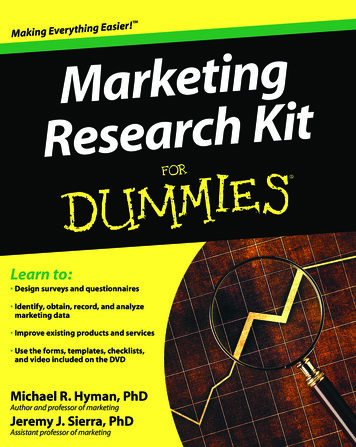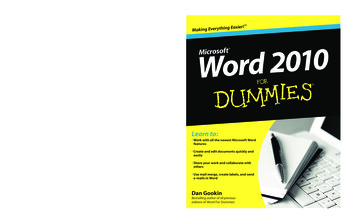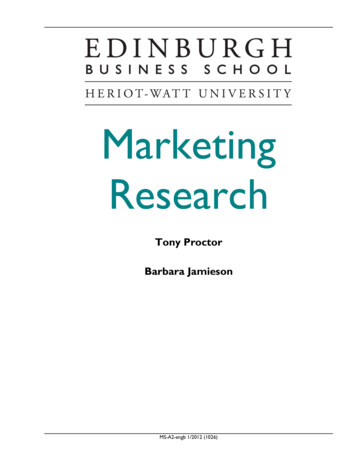
Transcription
g Easier!Making Everythin gnitekrMatiKhcResearLearn to: Design surveys and questionnaires Identify, obtain, record, and analyzemarketing data Improve existing products and services Use the forms, templates, checklists,and video included on the DVDMichael R. Hyman, PhDAuthor and professor of marketingJeremy J. Sierra, PhDAssistant professor of marketing
Get More and Do More at Dummies.com Start with FREE Cheat SheetsCheat Sheets include Checklists Charts Common Instructions And Other Good Stuff!To access the Cheat Sheet created specifically for this book, go et Smart at Dummies.comDummies.com makes your life easier with 1,000sof answers on everything from removing wallpaperto using the latest version of Windows.Check out our Videos Illustrated Articles Step-by-Step InstructionsPlus, each month you can win valuable prizes by enteringour Dummies.com sweepstakes. *Want a weekly dose of Dummies? Sign up for Newsletters on Digital Photography Microsoft Windows & Office Personal Finance & Investing Health & Wellness Computing, iPods & Cell Phones eBay Internet Food, Home & GardenFind out “HOW” at Dummies.com*Sweepstakes not currently available in all countries; visit Dummies.com for official rules.
MarketingResearch KitFORDUMmIES‰by Michael R. Hyman, PhDand Jeremy J. Sierra, PhD
Marketing Research Kit For Dummies Published byWiley Publishing, Inc.111 River St.Hoboken, NJ 07030-5774www.wiley.comCopyright 2010 by Wiley Publishing, Inc., Indianapolis, IndianaPublished by Wiley Publishing, Inc., Indianapolis, IndianaPublished simultaneously in CanadaNo part of this publication may be reproduced, stored in a retrieval system or transmitted in any form orby any means, electronic, mechanical, photocopying, recording, scanning or otherwise, except as permitted under Sections 107 or 108 of the 1976 United States Copyright Act, without either the prior writtenpermission of the Publisher, or authorization through payment of the appropriate per-copy fee to theCopyright Clearance Center, 222 Rosewood Drive, Danvers, MA 01923, (978) 750-8400, fax (978) 646-8600.Requests to the Publisher for permission should be addressed to the Permissions Department, John Wiley& Sons, Inc., 111 River Street, Hoboken, NJ 07030, (201) 748-6011, fax (201) 748-6008, or online at http://www.wiley.com/go/permissions.Trademarks: Wiley, the Wiley Publishing logo, For Dummies, the Dummies Man logo, A Reference for theRest of Us!, The Dummies Way, Dummies Daily, The Fun and Easy Way, Dummies.com, Making EverythingEasier, and related trade dress are trademarks or registered trademarks of John Wiley & Sons, Inc. and/or its affiliates in the United States and other countries, and may not be used without written permission.All other trademarks are the property of their respective owners. Wiley Publishing, Inc., is not associatedwith any product or vendor mentioned in this book.LIMIT OF LIABILITY/DISCLAIMER OF WARRANTY: THE PUBLISHER AND THE AUTHOR MAKE NOREPRESENTATIONS OR WARRANTIES WITH RESPECT TO THE ACCURACY OR COMPLETENESS OFTHE CONTENTS OF THIS WORK AND SPECIFICALLY DISCLAIM ALL WARRANTIES, INCLUDING WITHOUT LIMITATION WARRANTIES OF FITNESS FOR A PARTICULAR PURPOSE. NO WARRANTY MAY BECREATED OR EXTENDED BY SALES OR PROMOTIONAL MATERIALS. THE ADVICE AND STRATEGIESCONTAINED HEREIN MAY NOT BE SUITABLE FOR EVERY SITUATION. THIS WORK IS SOLD WITH THEUNDERSTANDING THAT THE PUBLISHER IS NOT ENGAGED IN RENDERING LEGAL, ACCOUNTING, OROTHER PROFESSIONAL SERVICES. IF PROFESSIONAL ASSISTANCE IS REQUIRED, THE SERVICES OFA COMPETENT PROFESSIONAL PERSON SHOULD BE SOUGHT. NEITHER THE PUBLISHER NOR THEAUTHOR SHALL BE LIABLE FOR DAMAGES ARISING HEREFROM. THE FACT THAT AN ORGANIZATION OR WEBSITE IS REFERRED TO IN THIS WORK AS A CITATION AND/OR A POTENTIAL SOURCEOF FURTHER INFORMATION DOES NOT MEAN THAT THE AUTHOR OR THE PUBLISHER ENDORSESTHE INFORMATION THE ORGANIZATION OR WEBSITE MAY PROVIDE OR RECOMMENDATIONS ITMAY MAKE. FURTHER, READERS SHOULD BE AWARE THAT INTERNET WEBSITES LISTED IN THISWORK MAY HAVE CHANGED OR DISAPPEARED BETWEEN WHEN THIS WORK WAS WRITTEN ANDWHEN IT IS READ.For general information on our other products and services, please contact our Customer CareDepartment within the U.S. at 877-762-2974, outside the U.S. at 317-572-3993, or fax 317-572-4002.For technical support, please visit www.wiley.com/techsupport.Wiley also publishes its books in a variety of electronic formats. Some content that appears in print maynot be available in electronic books.Library of Congress Control Number: 2010922048ISBN: 978-0-470-52068-0Manufactured in the United States of America10 9 8 7 6 5 4 3 2 1
About the AuthorsMichael R. Hyman, PhD, is the Stan Fulton Chair of Marketing at New MexicoState University in Las Cruces, New Mexico. He earned his undergraduatedegree at the University of Maryland and his master’s and doctoral degreesat Purdue University. Back in the day, he fancied himself a Texan — he was afaculty member at the University of Houston and then later at the University ofNorth Texas — but he has since become a loyal green-chile-eating, motorcycleriding, non-tie-wearing New Mexican.Mike has taught marketing research at the undergraduate, masters, anddoctoral levels for more years than he cares to admit (30 and counting).Although they occasionally suggest that his exams are overly challenging,students never complain that his research courses are poorly structured orlack sufficient rigor.Roughly 20 years ago, Mike toyed with the idea of leaving academia for fulltime consulting. For almost three years, he consulted extensively with majorhospitality industry clients. After straddling the university-consulting fenceduring this period, he decided — with the help of several perpetually annoying colleagues — that he was best suited to university life. Although he stillaccepts the occasional consulting gig, he has never regretted that decision.Nonetheless, he learned more about “real world” marketing research duringthose three years than during all his years of schooling.Golfing and fishing are Mike’s only “Type B” activities. When not teaching,spending time with his family, playing poker, or following the exploits of hisbeloved New York Yankees (a remnant of his misspent youth), he’s usuallypreoccupied with some writing project. His roughly 70 academic journalarticles, 45 conference papers (10 which won a “best paper” award), 2 books,15 other academic works, and 20 nonacademic works attest to this writingcompulsion. He’s also a sucker for professional service requests; amongother activities, he’s been talked into serving on 13 journal editorial boards,reviewing an excessive number of manuscripts and books each year, servingas a journal editor, and coordinating two different doctoral programs.Jeremy J. Sierra, PhD, is an Assistant Professor of Marketing at Texas StateUniversity — San Marcos. He teaches a wide array of marketing courses,including Marketing Research, which he has taught the past four years.Prior to joining the marketing faculty at Texas State, he taught at NorthernArizona University. He earned his MBA. and PhD from New Mexico StateUniversity and his BS in Hotel and Restaurant Management from CaliforniaState Polytechnic University, Pomona. Before entering academia, Jeremyaccumulated ten years of experience in the hospitality industry, where heacquired his knack for cost controls, customer relationship management,
and in-store design. His industry experience ranges from entrepreneurialrestaurant establishments to high-end resorts (for example, ScottsdalePrincess and Scottsdale Plaza Resort) and golf club environments (forexample, Frenchman’s Creek Country Club in Palm Beach Gardens, Florida).Jeremy’s research interests include advertising effects, consumer behavior,marketing ethics, and services marketing. Jeremy’s research is publishedin the following journals: Journal of Academic Ethics; Journal of Advertising;Journal of Business and Management; Journal of Current Issues & Research inAdvertising; Journal of Marketing Education; Journal of Marketing Theory andPractice; and Journal of Services Marketing. Jeremy has presented numerous conference proceedings, including two “best paper” awards, and hasreceived a research grant from the Research Enhancement Program at TexasState. He is an avid golfer and an ardent Nebraska football fan, and he also ishopeful that this book will make you a better marketing researcher.Authors’ AcknowledgmentsMike: To read about every person who ever inspired me, and as a result thisbook, would be at best a mind-numbing experience. That said, certain peoplewere more directly and indirectly influential in its creation and thereforeespecially deserving of acknowledgment.My wife, Stacey, and sons, Aaron, Derek, and Evan, should be commended fortheir tolerance with my oft-uttered “Daddy would love to spend time with younow, but he’s got to work on his book.” Of course, the boys’ college funds willbenefit from their patience, so I prefer to rationalize their considerateness as“enlightened self–interest.” Regardless, they are my primary motivation forawakening each morning. (Translation: They arise at 6 a.m. and make enoughnoise to wake the dead.)My parents, Aaron and Selma, reinforced my genetic predisposition towardworkaholism with a perpetual Get-Out-of-Jail-Free card. They alwaysforgave any personal transgression — such as forgetting to call on theiranniversary — when I could attribute it to my preoccupation with a school orwork-related project. In essence, they encouraged the type of self-absorptionrequisite to a large writing project like this book.Robin Peterson, a partner in crime and the best golfing buddy on the planet —when he doesn’t almost flip our cart — effectively discouraged me from dwelling on his many non-lucrative book-authoring efforts. Sadly, he often failed toconvince me that I would benefit more from an afternoon of golf than an afternoon of writing. Now that this book is finished, he will ensure that I renew mysupport of the golf ball industry.
Unlike the drama junkies who inflict discord and dysfunction on many academic departments, my colleagues at New Mexico State University are trulywonderful people. No one could find better co-workers and friends thanPookie Sautter, Jerry Hampton, Kelly Tian, Kevin Boberg, Bruce Huhmann,Michelle Jasso, Collin Payne, Mihai Niculescu, Pat Gavin, and VirginiaEspinosa. By making my life so easy, they allowed me the time and energyneeded to write this book.I would be remiss if I failed to thank the many students throughout the yearswho enrolled in my marketing research course. They taught me more aboutteaching than all other sources combined and had an enormous influence onthe quality of this book.Finally, I also would be remiss if I failed to thank my Wiley editorial teammates for their trust and patience. When I initially panicked over the magnitude of this project, Mike Baker repeatedly reassured me that Jeremyand I could complete it. Natalie Harris, Jessica Smith, and Christy Pingletonensured that the text never drifted into obtuse esoteric academese (like thelast phrase). Thanks also to Jenny Swisher and the Media Development teamfor their help in setting up the DVD.Jeremy: For brevity, I would like to acknowledge a few essential people(although there are a host of others) that have helped me along the way. Forher love, companionship, and support, I would like to thank my wife, Dian;she is the best co-pilot a guy could ask for. To my Mom who showed me persistence growing up, although I never asked her what it was. To my Dad whowould hit countless fly balls to me and throw hours of batting practice; thesewere his ways of communicating that in life, your toughest competitor isyourself. To my Grandma, for her love and support throughout my life, especially during my 11-year, 3-degree process. I also would like to acknowledgeand thank my mentors, colleagues, students, and former professors for theirinsight about marketing. Finally, to the underdog, which I usually side withunless they’re playing Nebraska: You inspire and make the world a betterplace. Keep the upsets coming.DedicationMike: To Aaron, father and son.Jeremy: To my wife and family, the underdog, and the loving memory of myMom.
Publisher’s AcknowledgmentsWe’re proud of this book; please send us your comments at http://dummies.custhelp.com.For other comments, please contact our Customer Care Department within the U.S. at 877-762-2974,outside the U.S. at 317-572-3993, or fax 317-572-4002.Some of the people who helped bring this book to market include the following:Acquisitions, Editorial, andMedia DevelopmentProject Editor: Natalie Faye HarrisComposition ServicesProject Coordinator: Kristie ReesCopy Editors: Jessica Smith, Christy PingletonLayout and Graphics: Carl Byers,Ashley Chamberlain, Yovonne Grego,Mark Pinto, Christine WilliamsAssistant Editor: Erin Calligan MooneyProofreaders: John Greenough, Toni SettleEditorial Program Coordinator: Joe NiesenIndexer: Potomac Indexing LLCAcquisitions Editor: Mike BakerTechnical Reviewer: John HallMedia Development Producer:Jennifer SwisherEditorial Manager: Christine Meloy BeckEditorial Assistant: Jennette ElNaggar,David LuttonArt Coordinator: Alicia B. SouthCover Photos: Chris Thomaidis/Stone/GettyCartoons: Rich Tennant(www.the5thwave.com)Publishing and Editorial for Consumer DummiesDiane Graves Steele, Vice President and Publisher, Consumer DummiesKristin Ferguson-Wagstaffe, Product Development Director, Consumer DummiesEnsley Eikenburg, Associate Publisher, TravelKelly Regan, Editorial Director, TravelPublishing for Technology DummiesAndy Cummings, Vice President and Publisher, Dummies Technology/General UserComposition ServicesDebbie Stailey, Director of Composition Services
Table of ContentsIntroduction . 1About This Book . 1Conventions Used in This Book . 2What You’re Not to Read . 2Foolish Assumptions . 3How This Book Is Organized . 4Part I: Marketing Research: Learn It, Live It, Love It . 4Part II: Surveys: A Great Way to Research . 4Part III: More Methods to Meet Your Needs . 4Part IV: Collecting, Analyzing, and Reporting Your Data . 5Part V: The Part of Tens . 5Icons Used in This Book . 5Where to Go from Here . 6Part I: Marketing Research: Learn It, Live It, Love It . 7Chapter 1: Seeing What Marketing Research Can Do for You . . . . . . .9What Is Marketing Research? . 10Comparing Marketing Research to Marketing Information Systems . 11Using Research for Problem Identification and Problem Solving . 13Looking at problem-identification research . 13Becoming familiar with problem-solving research. 17The Most Appropriate Research at Each Stageof the Product Life Cycle. 19Making the Big Decision to Do (Or Not to Do) Marketing Research . 21When you should do marketing research. 22When you shouldn’t do marketing research . 24Chapter 2: Following the Stages of the MarketingResearch Process . . . . . . . . . . . . . . . . . . . . . . . . . . . . . . . . . . . . . . . . . . . .27Working Your Way through the Stages of Research . 28Stage 1: Identifying the problem . 28Stage 2: Designing the study . 30Stage 3: Selecting a sample . 31Stage 4: Gathering the data . 33Stage 5: Analyzing the results. 33Stage 6: Communicating the findings and their implications . 35Anticipating Outcomes . 36
viiiMarketing Research Kit For DummiesChapter 3: Surveying the Types of Research You May Do . . . . . . . . . .37Recognizing the Difference between Basic and Applied Research . 37Basic: The research you probably don’t care about . 38Applied: The research you want to do . 38Exploratory, Descriptive, and Causal Research:Picking Your Approach . 39Getting started: Exploratory research . 41Describing your market environment: Descriptive research . 43Identifying relationships: Causal research . 44Comparing Longitudinal Research and Cross-Sectional Research . 45Chapter 4: Believing In Marketing Research Ethics . . . . . . . . . . . . . . .47A Solid, To-the-Point Ethics Checklist. 47Keeping in Mind a Researcher’s Obligation to Respondents. 48Obtaining informed consent . 49Avoiding deception. 49Respecting respondent privacy . 53Avoiding Abuse of Research Clients . 56Making sure proprietary stuff stays proprietary . 57Conducting unnecessary research . 58Performing wrong or irrelevant research . 58Ignoring errors in ongoing studies . 59Using unwarranted shortcuts. 59Recognizing Clients’ Obligations to Researchers . 61Remembering Clients’ Obligations to Respondents . 62Recalling that Respondents Have Obligations, Too! . 63Chapter 5: Working with Independent Marketing Researchers . . . . .65Making the Choice to Solicit Outside Expertise . 65Sources of Inexpensive Research Help . 66College and university students . 66College and university research centers . 68College and university faculty . 69Small local firms . 70Qualities to Look for in a Researcher . 71Helpful throughout the process . 72Proper communication and analytical skills . 72A focus on partnership. 73High professional standards . 76Part II: Surveys: A Great Way to Research . 77Chapter 6: Different Types of Surveys You May Use . . . . . . . . . . . . . . .79Conducting Face-to-Face Interviews . 79Examining the general face-to-face setup . 80Performing intercept interviews . 81
Table of ContentsConducting Telephone Surveys . 82Reviewing the contemporary methods forconducting phone interviews . 83Reviewing the pros and cons . 85Noting the problems with telephone directories . 86Categorizing Self-Administered, Paper-and-Pencil Surveys . 86Mail surveys. 89Administered surveys . 90Publication insert and fax surveys . 90Opting for Self-Administered, Electronic Surveys . 91Browser-based surveys . 91E-mail-based surveys . 94Interactive kiosks . 95Internet samples . 96Logging Behaviors with Diary Panels. 97Strengths and weaknesses of diary panels . 97Questions answerable with diary panel data . 99A sample diary page . 100Factors to Consider When Choosing a Data-Collection Method . 101Understanding the Problems with Commercial Lists . 104Chapter 7: Recognizing Errors in Survey Research . . . . . . . . . . . . . . .105Respondent-Centric Survey Errors: Reviewing the Components . 105Random sampling error . 106Systematic error. 106Understanding why respondents provideinaccurate information . 108Tackling Nonresponse Error . 112Understanding the reasons people become nonrespondents . 112Encouraging respondent cooperation . 114Minimizing error by boosting your response rates. 114Managing Administrative Error . 119Interviewer cheating . 119Data processing errors. 120Looking at Reliability, Validity, Generalizability, and Sensitivity . 120Recognizing the difference between reliability and validity . 120Determining reliability and validity . 121Minimizing variation in responses. 123Testing for reliability and validity . 124Valuing study generalizability . 127Valuing measurement sensitivity. 127Chapter 8: Asking People about Their Attitudes . . . . . . . . . . . . . . . . .129What’s an Attitude? . 130Recognizing and Using the Three Attitude Components . 130Reviewing the Classic Hierarchy-of-Effects Model . 131Developing Sound Attitude Measures. 133Understanding the importance of theory in measuring attitudes .134Identifying your conceptual and operational definitions . 135ix
xMarketing Research Kit For DummiesBecoming Familiar with the Attitude Measurement Process . 137Strongly Recommended: The Popular Likert Scale . 138Constructing Likert scales . 139Structuring Likert-type scales . 142Semantic Differential (SD) Scales . 145Reviewing the limitations of SD scales . 146Limitations of profile analysis . 147Chapter 9: Writing Good Questions. . . . . . . . . . . . . . . . . . . . . . . . . . . . .153Comparing Open-Ended and Close-Ended Questions . 154Looking at open-ended questions. 154Explaining close-ended questions . 155Writing Good Questions . 157Only write questions that address your research problem . 157Write clear and precise questions . 158Include only mutually exclusive and exhaustive responses . 160Use natural and familiar language . 161Avoid leading questions. 162Ask one question at a time . 163Soften the impact of potentially objectionable questions. 165Generating Reliable and Valid Answers . 166Consider memory effects . 167Don’t ask respondents to make unnecessary calculations . 168Steer clear of impossibly specific questions . 169Control for order bias . 170Always provide equal comparisons . 170State both sides of an attitude scale inquestion stems (lead lines). 171Ask questions as complete sentences . 171Distinguish undecided responses from neutral ones . 172Formatting a Purchase Intent Scale . 173Designing Effective Graphic Rating Scales . 174Working with Comparative Scales. 178Ranking scales . 178Paired-comparison scales . 180Constant-sum scales . 182Q-sort . 183Dollar-metric scale . 184Chapter 10: Designing Good Questionnaires . . . . . . . . . . . . . . . . . . . .187What’s in a Good Questionnaire? . 188Finding qualified respondents with screenersand filter questions . 188Familiarizing yourself with skip patterns . 191Organizing your questions . 192Providing clear instructions . 195Creating an effective layout . 196
Table of ContentsFormatting consistently to guide respondents throughyour questionnaire. 197Choosing simple answer formats. 200Reviewing Guidelines for Cover Letters . 202Using Browser-Based Questionnaires . 205Understanding the advantages of browser-basedquestionnaires . 206Visualizing browser-based questionnaires. 207Reviewing some common on-screen display options . 207Creating an Internet survey . 208Pretesting: Ensuring Your Questionnaire Is a Good One . 209Chapter 11: Deciding on a Sample Type . . . . . . . . . . . . . . . . . . . . . . . .211Introducing Basic Sampling Terms . 211Getting Familiar with Nonprobability and Probability Samples . 214Examining the different types of nonprobability samples . 214Describing the different types of probability sampl
marketing data to work When money is tight and everything is on the line, you need to make sure you’ve done your homework. You need Marketing Research Kit For Dummies. Whether you’re an entrepreneur, a small business owner, or a marketer in a large organization, this powerful reso










